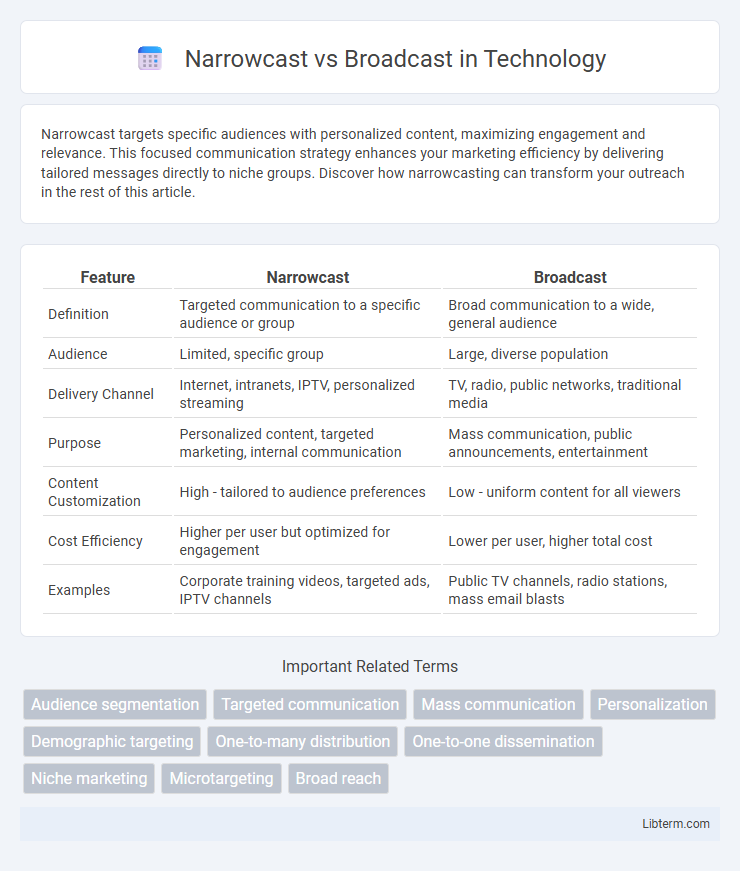Narrowcast targets specific audiences with personalized content, maximizing engagement and relevance. This focused communication strategy enhances your marketing efficiency by delivering tailored messages directly to niche groups. Discover how narrowcasting can transform your outreach in the rest of this article.
Table of Comparison
| Feature | Narrowcast | Broadcast |
|---|---|---|
| Definition | Targeted communication to a specific audience or group | Broad communication to a wide, general audience |
| Audience | Limited, specific group | Large, diverse population |
| Delivery Channel | Internet, intranets, IPTV, personalized streaming | TV, radio, public networks, traditional media |
| Purpose | Personalized content, targeted marketing, internal communication | Mass communication, public announcements, entertainment |
| Content Customization | High - tailored to audience preferences | Low - uniform content for all viewers |
| Cost Efficiency | Higher per user but optimized for engagement | Lower per user, higher total cost |
| Examples | Corporate training videos, targeted ads, IPTV channels | Public TV channels, radio stations, mass email blasts |
Understanding Narrowcast and Broadcast
Narrowcast targets specific, predefined audiences through personalized content distribution, enhancing engagement by tailoring messages based on demographics, interests, or behavior. Broadcast delivers content broadly to a wide, general audience via mass media channels such as television, radio, or large-scale online platforms, aiming for maximum reach rather than customization. Understanding the distinction between narrowcast and broadcast informs strategic communication decisions by aligning message delivery methods with audience segmentation and campaign goals.
Key Differences Between Narrowcast and Broadcast
Narrowcast targets a specific, well-defined audience segment with tailored content, whereas broadcast disseminates information to a broad, general audience without customization. Narrowcasting relies on precise demographic, geographic, or behavioral data to maximize relevance and engagement, while broadcasting prioritizes maximum reach across heterogeneous viewers. The key difference lies in audience scope and content specificity: narrowcast emphasizes focused communication for niche groups, broadcast emphasizes widespread distribution for mass consumption.
Audience Reach: Targeted vs. Mass
Narrowcast delivers content to a specific, well-defined audience segment, maximizing relevance and engagement through personalized messaging. Broadcast targets a broad, mass audience with the goal of reaching as many viewers or listeners as possible, often sacrificing personalization for scale. This fundamental difference impacts marketing strategies, with narrowcasting enabling precise audience targeting and broadcasting focusing on widespread exposure.
Content Personalization in Narrowcast
Narrowcast delivers content to specific, targeted audiences based on detailed demographics, preferences, or behaviors, enabling highly personalized and relevant messaging. Unlike broadcast, which sends uniform content to a broad, general population, narrowcasting leverages data-driven insights to tailor content that resonates individually, improving engagement and conversion rates. Personalized narrowcast content often uses dynamic segmentation and real-time analytics to continuously refine and optimize messaging effectiveness.
Media Channels Used for Broadcasting
Narrowcast utilizes targeted media channels such as email marketing, SMS, social media platforms with segmented audiences, and specialized cable TV networks to reach specific demographics or interest groups. Broadcast relies on mass media channels including terrestrial television, radio, and satellite networks to deliver content to a broad, diverse audience simultaneously. Choosing between narrowcast and broadcast media channels depends on campaign goals, audience specificity, and budget constraints.
Technological Requirements for Each Approach
Narrowcast technology requires advanced targeting systems, including data analytics, user profiling, and digital delivery channels like IP-based networks or private broadcasting infrastructures to reach specific, segmented audiences efficiently. Broadcast technology relies on high-power transmitters, wide-range antennas, and standardized frequency allocation to distribute content universally to vast, heterogeneous populations without personalized data handling. Equipment costs for narrowcasting tend to be higher due to precision software and network complexity, while broadcasting demands significant investment in transmission towers and spectrum licensing for broad geographic coverage.
Cost Effectiveness: Narrowcast vs. Broadcast
Narrowcast offers higher cost effectiveness by targeting specific audiences, reducing wasted expenditures on uninterested viewers, unlike Broadcast which incurs higher costs reaching broad, diverse demographics. The precise ad delivery in Narrowcast maximizes ROI by focusing budget on niche segments, whereas Broadcast requires substantial funding for broad-spectrum content distribution. Businesses seeking optimized budget allocation benefit more from Narrowcast's ability to tailor campaigns and minimize overall marketing spend.
Engagement Rates and User Interaction
Narrowcast targets specific audience segments with tailored content, resulting in higher engagement rates and more meaningful user interactions compared to broadcast methods that deliver generic messages to a broad audience. Personalized messaging in narrowcasting increases click-through rates by up to 45%, enhancing conversion potential and fostering stronger brand loyalty. Broadcast methods, while effective for mass awareness, generally show lower interaction rates due to less relevant content for individual viewers.
Real-World Examples of Narrowcast and Broadcast
Broadcast communication is exemplified by traditional television networks like NBC and CNN, which transmit signals to a wide, general audience without targeting specific demographics. Narrowcast communication is illustrated by platforms such as Netflix or HBO Max, where content is tailored and delivered to specific user groups based on preferences and subscription status. Furthermore, digital marketing campaigns using social media ads on Facebook or LinkedIn target narrow audience segments, showcasing the precision of narrowcasting compared to the broad reach of broadcast methods.
Choosing the Right Strategy for Your Business
Selecting between narrowcast and broadcast strategies hinges on your business's target audience and marketing goals. Narrowcasting delivers tailored content to specific segments, increasing engagement through personalized messaging, while broadcasting reaches a wider, general audience to build broad brand awareness. Evaluate your product's niche, customer demographics, and budget constraints to determine whether focused precision or mass exposure will yield the highest return on investment.
Narrowcast Infographic

 libterm.com
libterm.com